Cardiocondyla mauritanica
| Cardiocondyla mauritanica | |
|---|---|

| |
| Scientific classification | |
| Kingdom: | Animalia |
| Phylum: | Arthropoda |
| Class: | Insecta |
| Order: | Hymenoptera |
| Family: | Formicidae |
| Subfamily: | Myrmicinae |
| Tribe: | Crematogastrini |
| Genus: | Cardiocondyla |
| Species group: | nuda |
| Species complex: | mauritanica |
| Species: | C. mauritanica |
| Binomial name | |
| Cardiocondyla mauritanica Forel, 1890 | |
| Synonyms | |
| |
C. mauritanica is mainly a species of semi-deserts and other xerothermous habitats and the most widely distributed tramp species of the C. nuda group. Mating is strictly intranidal and colonies are polygynous (Heinze et al. 1993), traits considered preadaptations for the tramp species strategy. Winged males are unknown, wingless ergatoid males use their shear-shaped mandibles to crush the cuticle and to cut off the legs and antennae of other freshly emerged males (Heinze et al. 1993). (Seifert et al., 2017)
| At a Glance | • Highly invasive |
Identification
A member of the Cardiocondyla nuda group.
Sharaf et al. (2017) - Worker. Clypeus with few longitudinal rugae; mesosoma usually with well-developed microreticulum; metanotal groove shallow; propodeal spines short and blunt; postpetiole narrow, roughly hexagonal in dorsal view, with a flat sternite, and distinctly lower than petiole in profile. Colour variable, dorsal head dark brown, mesosoma, petiole and postpetiole orange brown, gaster bark brown to blackish brown.
Seifert et al. (2017) - There is no doubt that species separation in the C. nuda group is difficult. It requires careful consideration of character definitions and the use high-resolution optical and measurement systems. The diagnose presented here uses numerous morphological characters to achieve an acceptable identification error rate.
Meeting the following definition:
- Discriminant 176.328×PPH - 49.049×CW + 51.521×SP - 59.844×PPW + 6.61 < 0
- Discriminant 214.193×PLG - 88.759×SP + 57.676×SL - 106.17×PEH - 10.465 < 0
where:
- CW
- Maximum cephalic width; the maximum is found usually across and including the eyes, exceptionally posterior of the eyes.
- PEH
- Maximum petiole height. The straight section of ventral petiolar profile at node level is the reference line perpendicular to which the maximum height of petiole node is measured at node level.
- PLG
- Mean length of pubescence hairs on dorsum of first gaster tergite as arithmetic mean of at least 7 measurements measured at magnifications of 320x.
- PPH
- Maximum postpetiole height; the lateral suture of dorsal and ventral sclerites is the reference line perpendicular to which the maximum height of postpetiole is measured.
- PPW
- Maximum width of postpetiole.
- SL
- Maximum straight line length of scape excluding the articular condyle given as the arithmetic mean of both scapes.
- SP
- Maximum length of propodeal spines; measured in dorsofrontal view along the long axis of the spine, from spine tip to a line that orthogonal to the long axis and touches the bottom of the interspinal meniscus (Fig. 3). Left and right SP are averaged. This mode of measuring is less ambiguous than other methods but yields higher spine length values in species with reduced spines. This is the case in the dentiform spines found in the C. nuda group where it is difficult to correctly define the long axis. In such cases, the deviation of the assumed spine axes from longitudinal mesosomal axis should not exceed 30°.
Keys including this Species
- Key to Cardiocondyla of Hispaniola
- Key to Holartic Cardiocondyla
- Key to Palaearctic Cardiocondyla
- Key to US Cardiocondyla species
Distribution
Seifert et al. (2017) - If the distributional centre is indicative, the native range of this species is supposed to extend from India over Pakistan west to the Middle East and the Mediterranean. The populations in the Canaries, the Nearctic and Indonesia were most probably founded by anthropogenous introduction. Partial sympatry with Cardiocondyla itsukii is observed in the Oriental region but C. mauritanica apparently has difficulties penetrating the Indo-Malayan ranges occupied by the other species of the group and it seems to be fully absent from the Australasian and Polynesian faunal regions.
Latitudinal Distribution Pattern
Latitudinal Range: 36.954444° to 12.44103°.
| North Temperate |
North Subtropical |
Tropical | South Subtropical |
South Temperate |
- Source: AntMaps
Distribution based on Regional Taxon Lists
Afrotropical Region: Saudi Arabia, Socotra Archipelago, United Arab Emirates.
Indo-Australian Region: Indonesia.
Nearctic Region: United States.
Neotropical Region: Grenada, Netherlands Antilles, Puerto Rico.
Oriental Region: India, Nepal, Pakistan.
Palaearctic Region: Afghanistan, Canary Islands, Cyprus, Egypt, Greece, Iberian Peninsula, Iran, Iraq, Israel, Italy, Jordan, Libya, Malta, Morocco, Oman, Portugal, Russian Federation, Tunisia (type locality), Türkiye, Ukraine.
Distribution based on AntMaps
Distribution based on AntWeb specimens
Check data from AntWeb
Countries Occupied
| Number of countries occupied by this species based on AntWiki Regional Taxon Lists. In general, fewer countries occupied indicates a narrower range, while more countries indicates a more widespread species. |
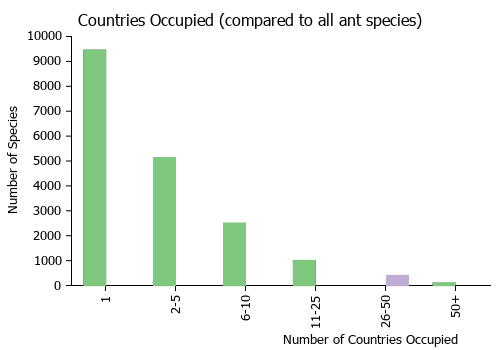
|
Estimated Abundance
| Relative abundance based on number of AntMaps records per species (this species within the purple bar). Fewer records (to the left) indicates a less abundant/encountered species while more records (to the right) indicates more abundant/encountered species. |

|
Habitat
Semi-deserts and other xerothermous habitats.
Biology
Espadaler (2007) - In the Canary Islands, found from 20 to 570 m in open dry habitats.
In Yemen Sharaf et al. (2017) observed workers foraging in wet, sandy soil next to a small stream. Some specimens were found in leaf litter under a date palm where the soil was moist and rich in decayed goat and sheep faecal material. Colonies contain less then 500 workers and may have more than one queen. New nests can be formed by fission.
Sharaf et al (2018) - Oman: found in leaf litter under a date palm tree where the soil was loose and dry.
Flight Period
| X | |||||||||||
| Jan | Feb | Mar | Apr | May | Jun | Jul | Aug | Sep | Oct | Nov | Dec |
Source: antkeeping.info.
- Check details at Worldwide Ant Nuptial Flights Data, AntNupTracker and AntKeeping.
- Explore: Show all Flight Month data or Search these data. See also a list of all data tables or learn how data is managed.
Castes
Worker
Images from AntWeb
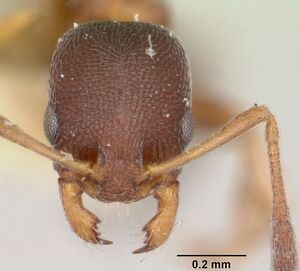   
| |
| Worker. Specimen code casent0103167. Photographer April Nobile, uploaded by California Academy of Sciences. | Owned by USNM, Washington, DC, USA. |
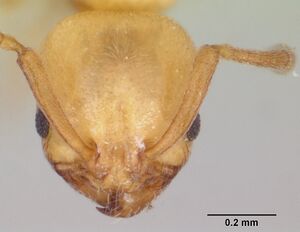   
| |
| Paratype of Cardiocondyla mauritanica. Worker. Specimen code casent0103433. Photographer April Nobile, uploaded by California Academy of Sciences. | Owned by LACM, Los Angeles, CA, USA. |
  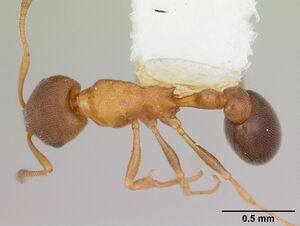 
| |
| Worker. Specimen code casent0103434. Photographer April Nobile, uploaded by California Academy of Sciences. | Owned by LACM, Los Angeles, CA, USA. |
   
| |
| Worker. Specimen code casent0104695. Photographer April Nobile, uploaded by California Academy of Sciences. | Owned by AMNH, New York, NY, USA. |
 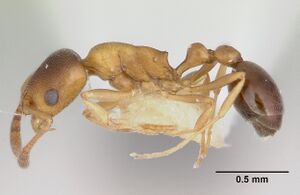  
| |
| Worker. Specimen code casent0172607. Photographer April Nobile, uploaded by California Academy of Sciences. | Owned by LACM, Los Angeles, CA, USA. |
Queen
Images from AntWeb
   
| |
| Queen (alate/dealate). Specimen code casent0172606. Photographer April Nobile, uploaded by California Academy of Sciences. | Owned by LACM, Los Angeles, CA, USA. |
    
| |
| Paratype of Cardiocondyla mauritanica. Queen (alate/dealate). Specimen code casent0103432. Photographer April Nobile, uploaded by California Academy of Sciences. | Owned by LACM, Los Angeles, CA, USA. |
Nomenclature
The following information is derived from Barry Bolton's Online Catalogue of the Ants of the World.
- mauritanica. Cardiocondyla nuda var. mauritanica Forel, 1890a: lxxv (w.) TUNISIA.
- Type-material: syntype workers (number not stated).
- Type-locality: Tunisia: Gabes, iii.-iv.1889 (A. Forel).
- Type-depository: MHNG.
- Forel, 1901e: 378 (q.); Forel, 1904c: 7 (ergatoid m.).
- Subspecies of nuda: Forel, 1890a: lxxv; Emery, 1891b: 13; Dalla Torre, 1893: 71; Forel, 1901b: 13; Forel, 1901e: 378; Forel, 1904c: 6; Emery, 1909a: 25; Forel, 1911f: 276; Forel, 1911h: 457; Karavaiev, 1911: 8; Crawley, 1920a: 165; Emery, 1922e: 126; Menozzi, 1927g: 379; Menozzi, 1932c: 94; Menozzi, 1933b: 58; Menozzi, 1934: 154; Finzi, 1936: 171; Teranishi, 1940: 35; Donisthorpe, 1942a: 28; Bernard, 1948: 141; Weber, 1952c: 17; Bernard, 1953a: 149; Kugler, J. 1984: 11; Mei, 1995: 764; Poldi, et al. 1995: 4.
- Status as species: Ortiz, F.J. & Tinaut, 1987: 32; Bolton, 1995b: 132; Espadaler, 1997b: 29; Seifert, 2003: 248 (redescription); Ward, 2005: 65; Cagniant, 2006a: 198; Gómez & Espadler, 2006: 226; Wetterer, Epadaler, Ashmole, et al. 2007: 31; Wetterer, et al. 2007: 9; Paknia, et al. 2008: 153; Vonshak, et al. 2009: 41; Legakis, 2011: 16; Collingwood, et al. 2011: 422; Borowiec, L. & Salata, 2012: 484; Kiran & Karaman, 2012: 17; Wetterer, 2012f: 985; Borowiec, L. 2014: 47; Bharti, Guénard, et al. 2016: 34; Lebas, et al. 2016: 266; Wetterer, et al. 2016: 10; Sharaf, Fisher, et al. 2017: 18; Seifert, Okita & Heinze, 2017: 338; Deyrup, 2017: 55; Salata & Borowiec, 2018c: 44; Sharaf, Fisher, et al. 2018: 18; Rasheed, et al. 2019: 431; Borowiec, L. & Salata, 2020: 5.
- Senior synonym of caparica: Henin, Collingwood & Paiva, 2003: 377; Seifert, Okita & Heinze, 2017: 338.
- Senior synonym of ectopia: Seifert, 2003: 248; Seifert, Okita & Heinze, 2017: 338.
- Senior synonym of nitida: Bernard, 1956c: 305; Bolton, 1995b: 132.
- Distribution [tramp species]
- Malesian: Indonesia (Lombok).
- Nearctic: U.S.A.
- Neotropical: Puerto Rico.
- Oriental: India, Pakistan.
- Palaearctic: Afghanistan, Egypt, Greece, Iraq, Iran, Israel, Jordan, Libya, Malta, Morocco, Oman, Portugal, Saudi Arabia, Spain, Tunisia, Turkey, United Arab Emirates.
- caparica. Leptothorax caparica Henin, Paiva & Collingwood, 2001: 163, figs. 1, 2 (w.) PORTUGAL.
- Type-material: holotype worker, 3 paratype workers.
- Type-locality: holotype Portugal: Peninsula of Setúbal, Herdade da Apostiça, 38°32’N, 09°09’W, 20.vi.2000 (J.M. Henin); paratypes with same data.
- Type-depositories: FUSG (holotype), FUSG, UNLP, WMLC (paratypes).
- Junior synonym of mauritanica: Henin, Collingwood & Paiva, 2003: 377; Seifert, Okita & Heinze, 2017: 338.
- ectopia. Cardiocondyla ectopia Snelling, R.R. 1974: 76, figs. 1-5 (w.q. ergatoid m.) U.S.A. (California).
- Type-material: holotype worker, 282 paratype workers, 17 paratype queens, 3 paratype males.
- Type-locality: holotype U.S.A: California, Orange County, Seal Beach, 25 ft, 17-24. vii.1972, no. 72-9 (R.R. Snelling); paratypes with same data.
- Type-depositories: LACM (holotype); AMNH, LACM, MCZC, USNM (paratypes).
- Status as species: Smith, D.R. 1979: 1375; Snelling, R.R. & George, 1979:117; Kugler, J. 1984: 12; Bolton, 1995b: 132; Mackay, 1995: 171 (in key).
- Junior synonym of mauritanica: Seifert, 2003a: 248; Seifert, Okita & Heinze, 2017: 338.
- nitida. Cardiocondyla emeryi subsp. nitida Bernard, 1948: 142 (w.) LIBYA.
- Type-material: 2 syntype workers.
- Type-locality: Libya: nr Brak, v.1945 (F. Bernard).
- Type-depository: MNHN.
- Subspecies of emeryi: Bernard, 1953a: 148.
- Junior synonym of mauritanica: Bernard, 1956c: 305; Bolton, 1995b: 132.
Unless otherwise noted the text for the remainder of this section is reported from the publication that includes the original description.
Seifert (2003) - Throughout the cosmopolitan range of C. mauritanicas only minor variation in morphometry is detectable. C. mauritanica specimens from India (Punjab, Himachal Pradesh) have a slightly narrower postpetio1e and slightly shorter spines. Furthermore, there is a certain trend from NW Africa east to India to have the petiole node lower and more rounded in profile (not quadrate as in the Tunisian type population).
The Old World population and the American population (the synonomized Cardiocondyla ectopia) are almost identical in body shape, surface structures, and morphometry. In both workers and gynes the American specimens are fully within the range and very close to the mean values of Old World C. mauritanica though weak statistic differences are detectable in worker petiole width and strength of sculpture (see above). Conspecifity is further indicated by the high similarity of the characteristic ergatoid males from typical C. mauritanica and C. ectopia populations and by mDNA data (Trindl and Heinze, pers. comm., October 2002).
Description
Worker
Seifert (2003) - Head elongated, CL/CW 1.183. Postocular index large, PoOc/CL 0.447. Eyes relatively small, EYE 0.232. Frontal carinae immediately caudal of the FRS level parallel or only very slightly converging. Foveolae on vertex not separated by interspaces, deeply impressed, with 17 - 22 ϻm diameter and on paramedian vertex usually without inner corona. Longitudinal sculpture on vertex relatively well developed but obscured by their merging with strong foveolar margins. Median vertex and frontal laminae finely longitudinally carinulate; clypeus with few longitudinal rugae. Whole mesosoma usually with well-developed microreticulum, but less strong than in C. nuda; samples with weak mesosomal microsculpture, meaning mildly shining overall surface appearance, may occur locally throughout the range. Metapleuron laterally longitudinally rugulose. Surface of 1st gaster tergite completely glabrous, a delicate microreticulum, as present in C. nuda and C. paranuda, is absent, but fragmentary reticulate structures may occur. Metanotal groove more or less shallow. Spines short and blunt. Petiole narrow, PEW/CS 0.265, node slightly longer than wide. Postpetiole relatively narrow, roughly hexagonal in dorsal aspect, with completely flat stemite, and distinctly lower than petiole, PEH/PPH 1.146 ± 0.034 [1.057 - 1.256]. Colour variable. Typically, dorsal head dark brown, mesosoma and waist orange brown, gaster dark to blackish brown. Lighter brown or, on the other hand, concolorous blackish brown samples may locally occur throughout the range.
Queen
Seifert (2003) - Head of medium length, CL/CW 1.171. Postocular index large, PoOc/CL 0.434. Occipital margin straight or weakly concave. Frontal carinae diverging caudad. Head sculpture comparable to worker. Whole dorsal area of meso soma densely and deeply foveolate; lateral area of mesosoma with longitudinal rugosity superimposing the microreticulum. Spines short and blunt. Shape of waist similar to worker but segments slightly wider and higher. Postpetiole significantly lower than petiole, PEH/PPH 1.154 ± 0.036 [1.089, 1.230]. Dorsal area of head, dorsal area of mesosoma, and gaster in typical case dark to blackish brown, lateral area of mesosoma and petiole lighter brown. Concolorous dark brown or lighter brown specimens may occur.
References
- Creighton, W. S.; Snelling, R. R. 1974. Notes on the behavior of three species of Cardiocondyla in the United States (Hymenoptera: Formicidae). Journal of the New York Entomological Society 82:82-92.
- Alatorre-Bracamontes, C.E., Vásquez-Bolaños, M. 2010. Lista comentada de las hormigas (Hymenoptera: Formicidae) del norte de México. Dugesiana 17(1): 9-36.
- Arcos, J., Chaves, D., Alarcón, P., Rosado, A. 2022. First record of Temnothorax convexus (Forel, 1894) in Portugal (Hymenoptera: Formicidae) with an updated checklist of the ants from the country. Sociobiology, 69(2), e7623 (doi:10.13102/sociobiology.v69i2.7623).
- Arcos, J., Chaves, D., Alarcón, P., Rosado, Á. 2022. First record of Temnothorax convexus (Forel, 1894) in Portugal (Hymenoptera: Formicidae) with an updated checklist of the ants from the country. Sociobiology, 692), e7623 (doi:10.13102/sociobiology.v69i2.7623).
- Baer, B. 2011. The copulation biology of ants (Hymenoptera: Formicidae). Myrmecological News 14: 55-68.
- Beibl, J., Stuart, R.J., Heinze, J., Foitzik, S. 2005. Six origins of slavery in formicoxenine ants. Insectes Sociaux 52, 291–297 (doi:10.1007/s00040-005-0808-y).
- Bernard, F. 1956c. Révision des fourmis paléarctiques du genre Cardiocondyla Emery. Bull. Soc. Hist. Nat. Afr. Nord 47: 299-306 (page 305, Senior synonym of nitida)
- Borowiec, L. 2014. Catalogue of ants of Europe, the Mediterranean Basin and adjacent regions (Hymenoptera: Formicidae). Genus (Wroclaw) 25(1-2): 1-340.
- Borowiec, L., Salata, S. 2019. Next step in the invasion: Trichomyrmex mayri (Forel, 1902) new to the Philippines (Hymenoptera: Formicidae). Annals of the Upper Silesian Museum in Bytom Entomology 28:1-3 (doi:10.5281/ZENODO.2644912).
- Borowiec, L., Salata, S. 2020. Review of ants (Hymenoptera: Formicidae) from Jordan. Annals of the Upper Silesian Museum in Bytom, Entomology 29 (online 2): 1-26 (doi:10.5281/zenodo.3733156).
- Borowiec, L., Wieczorek, K., Salata, S. 2021. Review of ants (Hymenoptera: Formicidae) of the Dodecanese Archipelago, Greece. Annals of the Upper Silesian Museum in Bytom Entomology 30: 1-33 (doi:10.5281/ZENODO.5571270).
- Catarineu, C., Barberá, G.G., Reyes-López, J.L. 2018. Zoogeography of the ants (Hymenoptera: Formicidae) of southeastern Iberian Peninsula. Sociobiology 65, 383-396 (doi:10.13102/sociobiology.v65i3.2822).
- Collingwood, C.A., Agosti, D., Sharaf, M.R., van Harten, A. 2011. Order Hymenoptera, family Formicidae. Arthropod fauna of the UAE 4: 405-474.
- Dekoninck, W., Wauters, N., Delsinne, T. 2019. Capitulo 35. Hormigas invasoras en Colombia. Hormigas de Colombia.
- Dubovikoff, D.A., Yusupov, Z.M. 2017. Family Formicidae - Ants. In Belokobylskij S. A. and A. S. Lelej: Annotated catalogue of the Hymenoptera of Russia. Proceedingss of the Zoological Institute of the Russian Academy of Sciences 6: 197-210.
- Espadaler, X. 2007. The ants of El Hierro (Canary Islands). Pages 113-127 in R. R. Snelling, B. L. Fisher, and P. S. Ward, editors. Advances in ant systematics (Hymenoptera: Formicidae): homage to E. O. Wilson - 50 years of contributions. Memoirs of the American Entomological Institute, Gainesville, FL. 80:690 pp.
- Forel, A. 1890b. Fourmis de Tunisie et de l'Algérie orientale. Ann. Soc. Entomol. Belg. 34:lxi-lxxvi. (page lxxv, worker described)
- Forel, A. 1901j. Variétés myrmécologiques. Ann. Soc. Entomol. Belg. 45: 334-382 (page 378, queen described, race of nuda)
- Forel, A. 1904d. Miscellanea myrmécologiques. Rev. Suisse Zool. 12: 1-52 (page 6, ergatoid male described)
- Guillem, R., Bensusan, K. 2022. Thee new exotic species of ants (Hymenoptera, Formicidae) for Madeira, with comments on its myrmecofauna. Journal of Hymenoptera Research 91: 321–333 (doi:10.3897/jhr.91.81624).
- Henin, Jean-Marc, Collingwood, Cedric, and Paiva, Maria Rosa 2003. Synonymy between Leptothorax caparica Henin, Paiva & Collingwood, 2001 and Cardiocondyla mauritanica Forel, 1890 (Hymenoptera, Formicidae). Bol. Soc. Port. Entomol. 211: 377-378 (page 377, senior synonym of Cardiocondyla caparica and its junior synonyms, ectopia and nitida)
- Jacobs, S. 2020. Population genetic and behavioral aspects of male mating monopolies in Cardiocondyla venustula (Ph.D. thesis).
- Jansen, G., Savolainen, R. 2010. Molecular phylogeny of the ant tribe Myrmicini (Hymenoptera: Formicidae). Zoological Journal of the Linnean Society 160(3), 482–495 (doi:10.1111/j.1096-3642.2009.00604.x).
- Karaman, C., Kıran, K. 2018. New tramp ant species for Turkey: Tetramorium lanuginosum Mayr (Hymenoptera: Formicidae). Trakya University Journal of Natural Sciences 19(1), e1-e4 (doi:10.23902/trkjnat.340008).
- Kiran, K., Karaman, C. 2020. Additions to the ant fauna of Turkey (Hymenoptera, Formicidae). Zoosystema 42(18), 285-329 (doi:10.5252/zoosystema2020v42a18).
- Meurgey, F. 2020. Challenging the Wallacean shortfall: A total assessment of insect diversity on Guadeloupe (French West Indies), a checklist and bibliography. Insecta Mundi 786: 1–183.
- Molfini, M., Zapparoli, M., Genovesi, P., Carnevali, L., Audisio, P., Di Giulio, A., Bologna, M.A. 2020. A preliminary prioritized list of Italian alien terrestrial invertebrate species. Biological Invasions 22(8), 2385–2399 (doi:10.1007/s10530-020-02274-w).
- Ortiz, F. J.; Tinaut, A. 1987. Citas nuevas o interesantes de Formícidos (Hym. Formicidae) para Andalucía. Bol. Asoc. Esp. Entomol. 11: 31-34 (page 32, Raised to species)
- Oussalah, N., Marniche, F., Espadaler, X., Biche, M. 2019. Exotic ants from the Maghreb (Hymenoptera, Formicidae) with first report of the hairy alien ant Nylanderia jaegerskioeldi (Mayr) in Algeria. Arxius de Miscel·lània Zoològica, 45–58 (doi:10.32800/amz.2019.17.0045).
- Rasheed, M.T., Bodlah, I., Fareen, A.G., Wachkoo, A.A., Huang, X., Akbar, S.A. 2019. A checklist of ants (Hymenoptera: Formicidae) in Pakistan. Sociobiology 66(3), 426-439 (doi:10.13102/sociobiology.v66i3.4330).
- Rasheed, S.B., Ali, M., Zaidi, F., Noreen, S. 2020. Diversity of ants (Hymenoptera: Formicidae) in residential area of Tarbela, Swabi: New recrds from Pakistan. The Journal of Animal and Plant Sciences 31: 617-624 (doi:10.36899/japs.2021.2.0250).
- Reyes López, J.; Luque García, G. 2001. Nuevos datos sobre el género Cardiocondyla (Hym., Formicidae) en Andalucía (en el Sur de la Península Ibérica). Bol. Asoc. Esp. Entomol. 25(3/4): 125-126 (page 125, record in Spain)
- Rosas-Mejía, M., Guénard, B., Aguilar-Méndez, M. J., Ghilardi, A., Vásquez-Bolaños, M., Economo, E. P., Janda, M. 2021. Alien ants (Hymenoptera: Formicidae) in Mexico: the first database of records. Biological Invasions 23(6), 1669–1680 (doi:10.1007/s10530-020-02423-1).
- Salata, S., Borowiec, L., Trichas, A. 2020. Review of ants (Hymenoptera: Formicidae) of Crete, with keys to species determination and zoogeographical remarks. Monographs of the Upper Silesian Museum No 12: 5–296 (doi:10.5281/ZENODO.3738001).
- Schifani, E., Nalini, E., Gentile, V., Alamanni, F., Ancona, C., Caria, M., Cillo, D., Bazzato, E. 2021. Ants of Sardinia: An updated checklist based on new faunistic, morphological and biogeographical notes. Redia 104, 21–35 (doi:10.19263/redia-104.21.03).
- Seifert, B. 2003a. The ant genus Cardiocondyla (Insecta: Hymenoptera: Formicidae) - a taxonomic revision of the C. elegans, C. bulgarica, C. batesii, C. nuda, C. shuckardi, C. stambuloffii, C. wroughtonii, C. emeryi, and C. minutior species groups. Ann. (page 248, senior synonym of ectopia)
- Seifert, B. 2022. The ant genus Cardiocondyla (Hymenoptera: Formicidae): The species groups with Oriental and Australasian origin. Diversity 15, 25 (doi:10.3390/d15010025).
- Seifert, B. 2023. A revision of the Palaearctic species of the ant genus Cardiocondyla Emery 1869 (Hymenoptera: Formicidae). Zootaxa 5274(1), 1–64 (doi:10.11646/zootaxa.5274.1.1).
- Seifert, B., Okita, I., Heinze, J. 2017. A taxonomic revision of the Cardiocondyla nuda group (Hymenoptera: Formicidae). Zootaxa 4290: 324–356 (doi:10.11646/zootaxa.4290.2.4).
- Sharaf, M.R., Abdel-Dayem, M.S., Mohamed, A.A., Fisher, B.L., Aldawood, A.S. 2020. A preliminary synopsis of the ant fauna (Hymenoptera: Formicidae) of Qatar with remarks on the zoogeography. Annales Zoologici 70: 533-560 (doi:10.3161/00034541anz2020.70.4.005).
- Sharaf, M.R., Al Dhafer, H.M., Abdel-Dayem, M.S., Aldawood, A.S. 2024. Cardiocondyla hashemi sp. n., a new species of the C. batesii species-group (Hymenoptera: Formicidae) from Saudi Arabia, with a key to the Saudi species. Zoology in the Middle East]] (doi:10.1080/09397140.2024.2321640).
- Sharaf, M.R., Fisher, B.L., Collingwood, C.A., Aldawood, A.S. 2017. Ant fauna (Hymenoptera: Formicidae) of the Socotra Archipelago (Yemen): zoogeography, distribution and description of a new species. Journal of Natural History 51, 317–378 (DOI 10.1080/00222933.2016.1271157).
- Sharaf, M.R., Fisher, B.L., Dhafer, H.M., Polaszek, A., Aldawood, S.A. 2018. Additions to the ant fauna (Hymenoptera: Formicidae) of Oman: an updated list, new records and a description of two new species. Asian Myrmecology. 9:e010004; 1-38. doi:10.20362/am.010004 10.20362/am.010004.
- Subedi, I.P., Budha, P.B., Bharti, H., Alonso, L. 2020. An updated checklist of Nepalese ants (Hymenoptera, Formicidae). ZooKeys 1006, 99–136 (doi:10.3897/zookeys.1006.58808).
- Tinaut, A., Ruano, F. 2021. Biogeography of Iberian ants (Hymenoptera: Formicidae). Diversity 13, 88. (doi:10.3390/d13020088).
- Trigos-Peral, G., Abril, S., Angulo, E. 2020. Behavioral responses to numerical differences when two invasive ants meet: the case of Lasius neglectus and Linepithema humile. Biological Invasions (doi:10.1007/s10530-020-02412-4).
- Varela-Hernández, F., Medel-Zosayas, B., Martínez-Luque, E.O., Jones, R.W., De la Mora, A. 2020. Biodiversity in central Mexico: Assessment of ants in a convergent region. Southwestern Entomologist 454: 673-686.
- Wetterer, J.K. 2012. Worldwide Spread of the Moorish sneaking Ant, Cardiocondyla mauritanica (Hymenoptera: Formicidae). Sociobiology 59, 985-997.
- Wetterer, J.K., Espadaler, X., Ashmole, N.P., Mendel, H., Cutler, C., Endeman, J. 2007. Ants (Hymenoptera: Formicidae) of the South Atlantic islands of Ascension Island, St Helena, and Tristan da Cunha. Myrmecological News 10: 29-37.
References based on Global Ant Biodiversity Informatics
- Bakr R. F. A., H. H. Fadl, R. M. Badawy, and M. R. Sharaf. 2007. Myrmecophile insects associated with some ant species (Hymenoptera : Formicidae )in Egypt. The second international conference of economic entomology (Entomological Society of Egypt) ,Cairo, Egypt, 8-11 December, (1): 205-233.
- Bernard F. 1953. Les fourmis du Tassili des Ajjer. Pp. 121-250 in: Bernard, F. (ed.) 1953. Mission scientifique au Tassili des Ajjer (1949). Volume I. Recherches zoologiques et médicales. Paris: P. Lechevalier, 302 pp.
- Bernard F. 1956. Révision des fourmis paléarctiques du genre Cardiocondyla Emery. Bull. Soc. Hist. Nat. Afr. Nord 47: 299-306.
- Borowiec L. 2014. Catalogue of ants of Europe, the Mediterranean Basin and adjacent regions (Hymenoptera: Formicidae). Genus (Wroclaw) 25(1-2): 1-340.
- Borowiec L., and S. Salata. 2012. Ants of Greece - Checklist, comments and new faunistic data (Hymenoptera: Formicidae). Genus 23(4): 461-563.
- Cagniant, H.. "Liste actualisee des fourmis du Maroc (Hymenoptera: Formicidae)." Myrmecologische Nachrichten 8 (2006): 193-200.
- Collingwood C. A., D. Agosti, M. R. Sharaf, A. Van Harten, 2011. Order Hymenoptera, family Formicidae. Arthropod Fauna of the UAE 4: 405-474
- Collingwood C.A., D.Agosti, M.R. Sharaf, and A. van Harten. 2011. Order Hymenoptera, family Formicidae. Arthropod fauna of the UAE, 4: 405474
- Crawley W. C. 1920. Ants from Mesopotamia and north-west Persia. Entomol. Rec. J. Var. 32: 162-166.
- Donisthorpe H. 1947. Results of the Armstrong College Expedition to Siwa Oasis (Libyan Desert), 1935: A second list of the Formicidae (Hymenoptera). Bulletin de la Société Fouad Ier d'Entomologie 31: 109-111.
- Finzi, B.. "Risultati scientifici della spedizione di S. A. S. il Principe Alessandro della Torre e Tasso nell'Egitto e peninsola del Sinai. XI. Formiche." Bulletin de la Société Entomologique d'Egypte 20 (1936): 155-210.
- Forel A. 1904. Miscellanea myrmécologiques. Rev. Suisse Zool. 12: 1-52.
- Forel A. 1911. Fourmis d'Afrique et d'Asie. I. Fourmis d'Afrique surtout du Musée du Congo Belge. Rev. Zool. Afr. (Bruss.) 1: 274-283.
- Forel, A.. "Fourmis de Tunisie et de l'Algerie orientale recoltees et decrites par Auguste Forel." Annales de la Société Entomologique de Belgique 34 (1890): lxi-lxxvi.
- Forel, A.. "Miscellanea myrmécologiques." Revue Suisse de Zoologie 12 (1904): 1-52.
- Karavaiev V. 1911. Ameisen aus Aegypten und dem Sudan. Rus. Entomol. Obozr. 11: 1-12.
- Kugler J. 1984. The males of Cardiocondyla Emery (Hymenoptera: Formicidae) with the description of the winged male of Cardiocondyla wroughtoni (Forel). Israel Journal of Entomology 17: 1-21.
- Menozzi C. 1927. Risultati zoologici della Missione inviata dalla R. Società Geografica Italiana per l'esplorazione dell'Oasi di Giarabub (1926-1927). Formicidae (Hymenoptera).. Annali del Museo Civico di Storia Naturale Giacomo Doria. 52: 379-382.
- Menozzi C. 1932. Spedizione scientifica all'Oasi di Cufra (marzo-luglio 1931). Formiche.. Annali del Museo Civico di Storia Naturale Giacomo Doria. 55: 451-456.
- Menozzi C. 1934. Reperti mirmecofaunistici raccolti dal Prof. L di Caporiacco nelle oasi di Cufra e in altre localita del deserto Libico. Atti della Societa dei Naturalisti e Matematici di Modena (6)13(65): 153-166
- Orabi G. M., F. M. Semida, M. S. Abdel-Dayem, M. R. Sharaf, and S. M. Zalat. 2011. Diversity patterns of ants along an elevation gradient at St. Catherine Protectorate, South Sinai, Egypt (Hymenoptera: Formicidae). Zoology in the Middle East 54(1): 101-112.
- Ortiz, F. J., and A. Tinaut. "Citas nuevas o interesantes de Formícidos para Andalucía." Boletín de la Asociación Española de Entomología 11 (1987): 31-34.
- Oussalah N., F. Marniche, X. Espadaler, and M. Biche. 2019. Exotic ants from the Maghreb (Hymenoptera, Formicidae) with first report of the Hairy Alien Ant Nylanderia jaegerskioeldi (Mayr) in Algeria. Arxius de Miscel·lania Zoologica 17: 45–58.
- Paknia O., A. Radchenko, H. Alipanah, and M. Pfeiffer. 2008. A preliminary checklist of the ants (Hymenoptera: Formicidae) of Iran. Myrmecological News 11: 151-159.
- Rasheed M. T., I. Bodlah, A. G. Fareen, A. A. Wachkoo, X. Huang, and S. A. Akbar. 2019. A checklist of ants (Hymenoptera: Formicidae) in Pakistan. Sociobiology 66(3): 426-439.
- Seifert B. 2003. The ant genus Cardiocondyla (Insecta: Hymenoptera: Formicidae) - a taxonomic revision of the C. elegans, C. bulgarica, C. batesii, C. nuda, C. shuckardi, C. stambuloffii, C. wroughtonii, C. emeryi, and C. minutior species groups. Annalen des Naturhistorischen Museums in Wien. B, Botanik, Zoologie 104: 203-338.
- Seifert B. 2008. Cardiocondyla atalanta Forel, 1915: a cryptic sister species of Cardiocondyla nuda (Mayr, 1866) (Hymenoptera, Formicidae). Myrmecological News 11: 43-48.
- Seifert B., I. Okita,and J. Heinze. 2017. A taxonomic revision of the Cardiocondyla nuda group (Hymenoptera: Formicidae). Zootaxa 4290: 324-356.
- Seifert, B.. "The ant genus Cardiocondyla (Insecta: Hymenoptera: Formicidae) - a taxonomic revision of the C. elegans, C. bulgarica. C. batesii, C. nuda, C. shuckardi, C. stambuloffii, C. wroughtonii, C. emeryi, and C. minutior species groups." Ann. Naturhist. Mus. Wien 104B (2003): 203-338.
- Taheri A., and J. Reyes-Lopez. 2017. First record in Morocco of the wooly ant Tetramorium lanuginosum (Hymenoptera: Formicidae), an Asian species now known from all southern Mediterranean countries. Transactions American Entomological Society 143: 515-516.
- Vonshak M., and A. Ionescu-Hirsch. 2009. A checklist of the ants of Israel (Hymenoptera: Formicidae). Israel Journal of Entomology 39: 33-55.
- Weber N. A. 1952. Observations on Baghdad ants. Baghdad: The Trading and Printing Co., 30 pp.
- Wetterer J. K. 2012. Worldwide spread of the moorish sneaking ant, Cardiocondyla mauritanica (Hymenoptera: Formicidae). Sociobiology 59: 985-997.

